BUS499 Principles of Economics Assignment: Market Analysis and Costs
VerifiedAdded on 2023/06/09
|9
|1780
|156
Homework Assignment
AI Summary
This assignment delves into the core principles of economics, examining the effects of government-imposed price controls, specifically price ceilings and price floors, on market equilibrium. It analyzes the impact of these controls using graphical representations, determining whether they are binding and creating shortages or surpluses. The assignment further explores the reasons behind policymakers' decisions to implement such controls. The second part of the assignment focuses on the average total cost (ATC) curve, explaining its U-shaped nature. It attributes this shape to the law of diminishing marginal returns and fixed costs, providing practical examples to illustrate how these factors influence a business's cost structure. The assignment concludes by summarizing the key concepts and their implications for market dynamics and business operations, highlighting the government's role in price regulation and the factors shaping production costs.
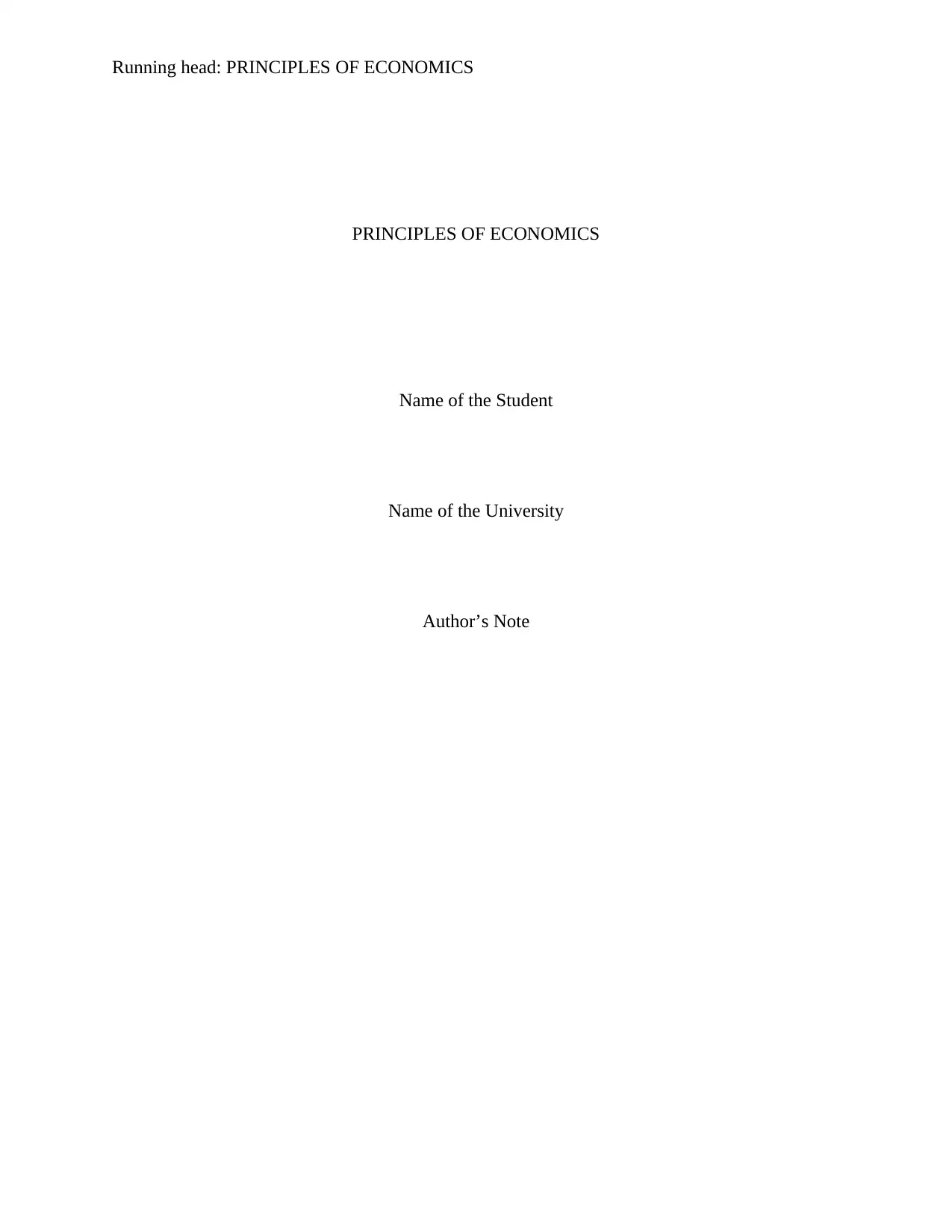
Running head: PRINCIPLES OF ECONOMICS
PRINCIPLES OF ECONOMICS
Name of the Student
Name of the University
Author’s Note
PRINCIPLES OF ECONOMICS
Name of the Student
Name of the University
Author’s Note
Paraphrase This Document
Need a fresh take? Get an instant paraphrase of this document with our AI Paraphraser
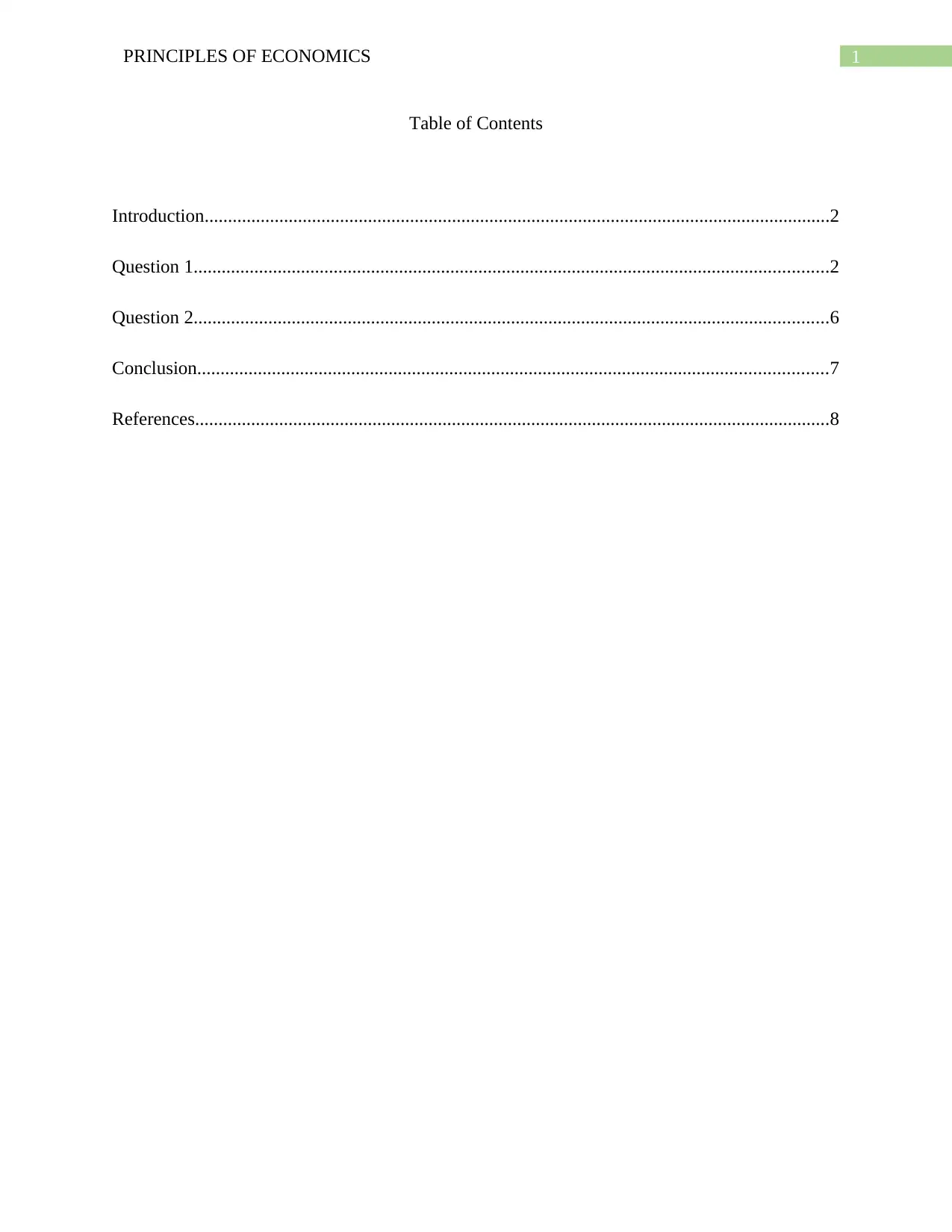
1PRINCIPLES OF ECONOMICS
Table of Contents
Introduction......................................................................................................................................2
Question 1........................................................................................................................................2
Question 2........................................................................................................................................6
Conclusion.......................................................................................................................................7
References........................................................................................................................................8
Table of Contents
Introduction......................................................................................................................................2
Question 1........................................................................................................................................2
Question 2........................................................................................................................................6
Conclusion.......................................................................................................................................7
References........................................................................................................................................8
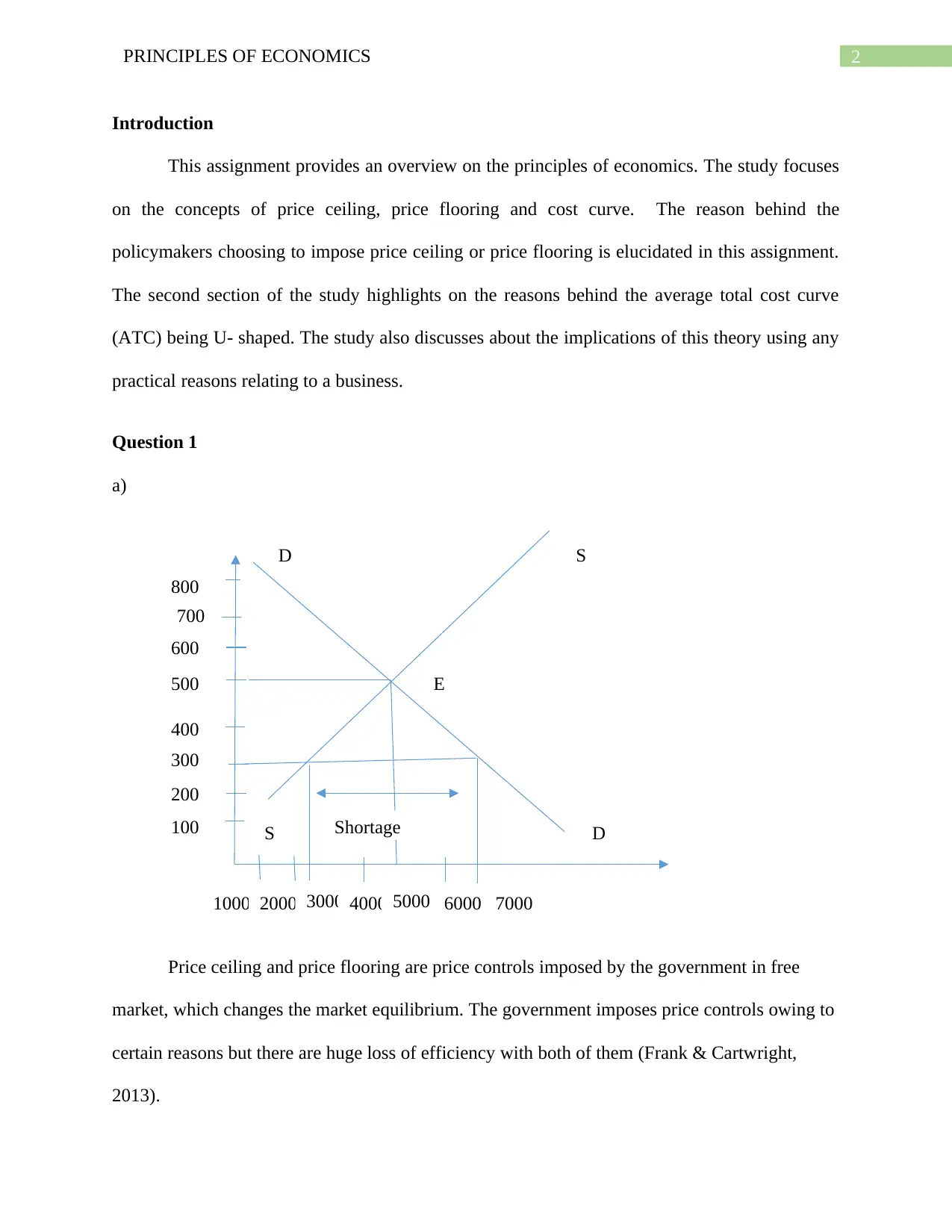
2PRINCIPLES OF ECONOMICS
100
200
300
500
600
700
800
400
1000 2000 3000 4000 5000 6000 7000
D
D S
S
E
Shortage
Introduction
This assignment provides an overview on the principles of economics. The study focuses
on the concepts of price ceiling, price flooring and cost curve. The reason behind the
policymakers choosing to impose price ceiling or price flooring is elucidated in this assignment.
The second section of the study highlights on the reasons behind the average total cost curve
(ATC) being U- shaped. The study also discusses about the implications of this theory using any
practical reasons relating to a business.
Question 1
a)
Price ceiling and price flooring are price controls imposed by the government in free
market, which changes the market equilibrium. The government imposes price controls owing to
certain reasons but there are huge loss of efficiency with both of them (Frank & Cartwright,
2013).
100
200
300
500
600
700
800
400
1000 2000 3000 4000 5000 6000 7000
D
D S
S
E
Shortage
Introduction
This assignment provides an overview on the principles of economics. The study focuses
on the concepts of price ceiling, price flooring and cost curve. The reason behind the
policymakers choosing to impose price ceiling or price flooring is elucidated in this assignment.
The second section of the study highlights on the reasons behind the average total cost curve
(ATC) being U- shaped. The study also discusses about the implications of this theory using any
practical reasons relating to a business.
Question 1
a)
Price ceiling and price flooring are price controls imposed by the government in free
market, which changes the market equilibrium. The government imposes price controls owing to
certain reasons but there are huge loss of efficiency with both of them (Frank & Cartwright,
2013).
You're viewing a preview
Unlock full access by subscribing today!
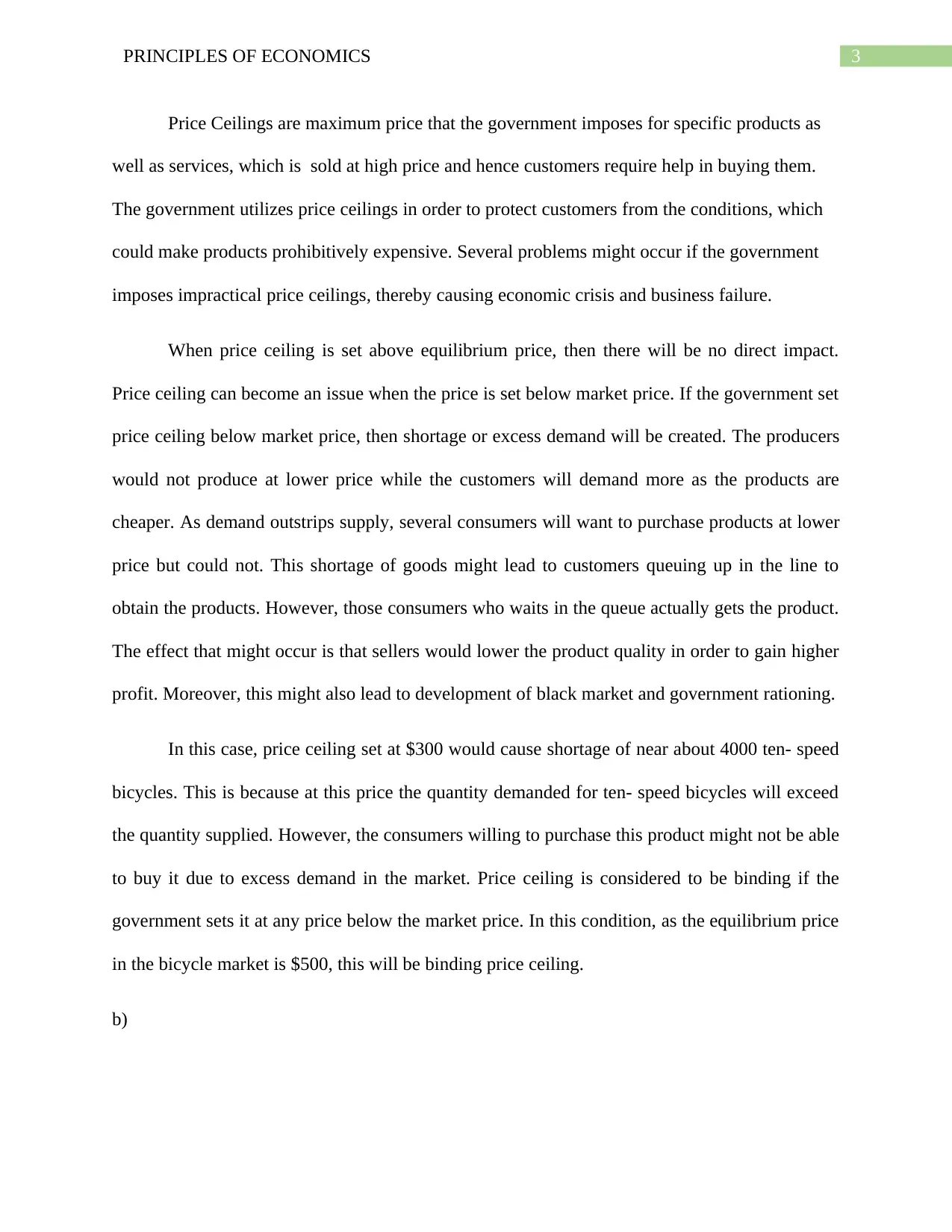
3PRINCIPLES OF ECONOMICS
Price Ceilings are maximum price that the government imposes for specific products as
well as services, which is sold at high price and hence customers require help in buying them.
The government utilizes price ceilings in order to protect customers from the conditions, which
could make products prohibitively expensive. Several problems might occur if the government
imposes impractical price ceilings, thereby causing economic crisis and business failure.
When price ceiling is set above equilibrium price, then there will be no direct impact.
Price ceiling can become an issue when the price is set below market price. If the government set
price ceiling below market price, then shortage or excess demand will be created. The producers
would not produce at lower price while the customers will demand more as the products are
cheaper. As demand outstrips supply, several consumers will want to purchase products at lower
price but could not. This shortage of goods might lead to customers queuing up in the line to
obtain the products. However, those consumers who waits in the queue actually gets the product.
The effect that might occur is that sellers would lower the product quality in order to gain higher
profit. Moreover, this might also lead to development of black market and government rationing.
In this case, price ceiling set at $300 would cause shortage of near about 4000 ten- speed
bicycles. This is because at this price the quantity demanded for ten- speed bicycles will exceed
the quantity supplied. However, the consumers willing to purchase this product might not be able
to buy it due to excess demand in the market. Price ceiling is considered to be binding if the
government sets it at any price below the market price. In this condition, as the equilibrium price
in the bicycle market is $500, this will be binding price ceiling.
b)
Price Ceilings are maximum price that the government imposes for specific products as
well as services, which is sold at high price and hence customers require help in buying them.
The government utilizes price ceilings in order to protect customers from the conditions, which
could make products prohibitively expensive. Several problems might occur if the government
imposes impractical price ceilings, thereby causing economic crisis and business failure.
When price ceiling is set above equilibrium price, then there will be no direct impact.
Price ceiling can become an issue when the price is set below market price. If the government set
price ceiling below market price, then shortage or excess demand will be created. The producers
would not produce at lower price while the customers will demand more as the products are
cheaper. As demand outstrips supply, several consumers will want to purchase products at lower
price but could not. This shortage of goods might lead to customers queuing up in the line to
obtain the products. However, those consumers who waits in the queue actually gets the product.
The effect that might occur is that sellers would lower the product quality in order to gain higher
profit. Moreover, this might also lead to development of black market and government rationing.
In this case, price ceiling set at $300 would cause shortage of near about 4000 ten- speed
bicycles. This is because at this price the quantity demanded for ten- speed bicycles will exceed
the quantity supplied. However, the consumers willing to purchase this product might not be able
to buy it due to excess demand in the market. Price ceiling is considered to be binding if the
government sets it at any price below the market price. In this condition, as the equilibrium price
in the bicycle market is $500, this will be binding price ceiling.
b)
Paraphrase This Document
Need a fresh take? Get an instant paraphrase of this document with our AI Paraphraser
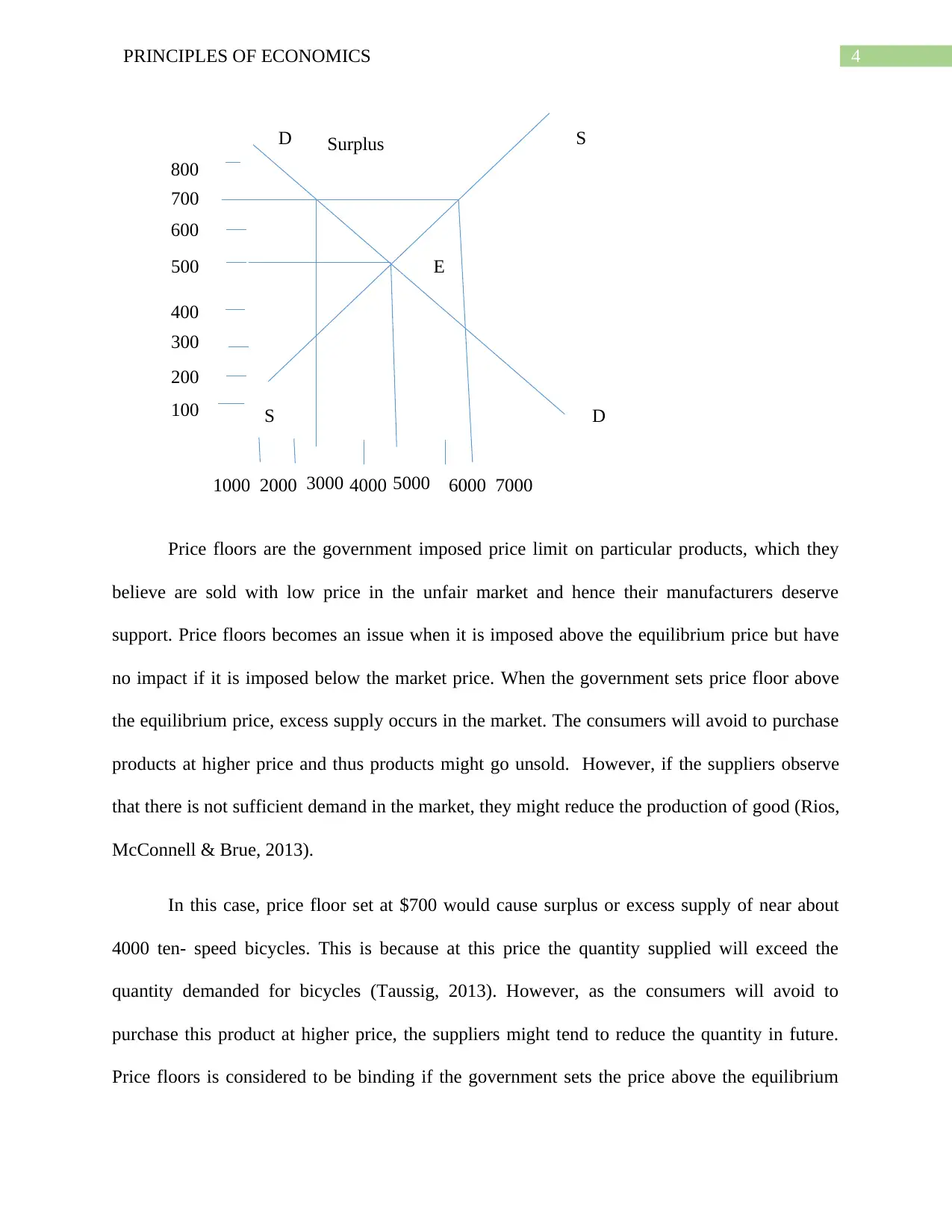
4PRINCIPLES OF ECONOMICS
100
200
300
500
600
700
800
400
1000 2000 3000 4000 5000 6000 7000
D
D S
S
E
Surplus
Price floors are the government imposed price limit on particular products, which they
believe are sold with low price in the unfair market and hence their manufacturers deserve
support. Price floors becomes an issue when it is imposed above the equilibrium price but have
no impact if it is imposed below the market price. When the government sets price floor above
the equilibrium price, excess supply occurs in the market. The consumers will avoid to purchase
products at higher price and thus products might go unsold. However, if the suppliers observe
that there is not sufficient demand in the market, they might reduce the production of good (Rios,
McConnell & Brue, 2013).
In this case, price floor set at $700 would cause surplus or excess supply of near about
4000 ten- speed bicycles. This is because at this price the quantity supplied will exceed the
quantity demanded for bicycles (Taussig, 2013). However, as the consumers will avoid to
purchase this product at higher price, the suppliers might tend to reduce the quantity in future.
Price floors is considered to be binding if the government sets the price above the equilibrium
100
200
300
500
600
700
800
400
1000 2000 3000 4000 5000 6000 7000
D
D S
S
E
Surplus
Price floors are the government imposed price limit on particular products, which they
believe are sold with low price in the unfair market and hence their manufacturers deserve
support. Price floors becomes an issue when it is imposed above the equilibrium price but have
no impact if it is imposed below the market price. When the government sets price floor above
the equilibrium price, excess supply occurs in the market. The consumers will avoid to purchase
products at higher price and thus products might go unsold. However, if the suppliers observe
that there is not sufficient demand in the market, they might reduce the production of good (Rios,
McConnell & Brue, 2013).
In this case, price floor set at $700 would cause surplus or excess supply of near about
4000 ten- speed bicycles. This is because at this price the quantity supplied will exceed the
quantity demanded for bicycles (Taussig, 2013). However, as the consumers will avoid to
purchase this product at higher price, the suppliers might tend to reduce the quantity in future.
Price floors is considered to be binding if the government sets the price above the equilibrium
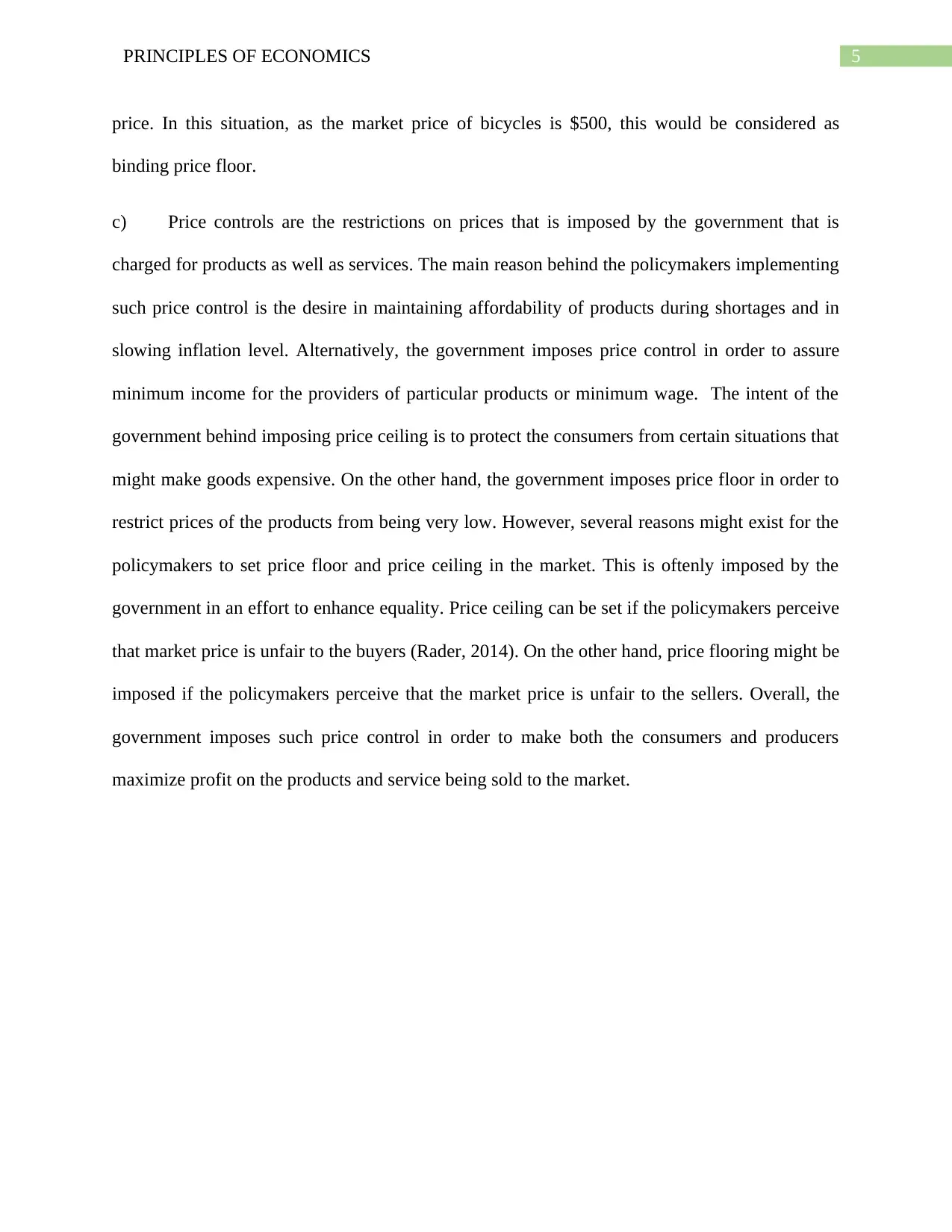
5PRINCIPLES OF ECONOMICS
price. In this situation, as the market price of bicycles is $500, this would be considered as
binding price floor.
c) Price controls are the restrictions on prices that is imposed by the government that is
charged for products as well as services. The main reason behind the policymakers implementing
such price control is the desire in maintaining affordability of products during shortages and in
slowing inflation level. Alternatively, the government imposes price control in order to assure
minimum income for the providers of particular products or minimum wage. The intent of the
government behind imposing price ceiling is to protect the consumers from certain situations that
might make goods expensive. On the other hand, the government imposes price floor in order to
restrict prices of the products from being very low. However, several reasons might exist for the
policymakers to set price floor and price ceiling in the market. This is oftenly imposed by the
government in an effort to enhance equality. Price ceiling can be set if the policymakers perceive
that market price is unfair to the buyers (Rader, 2014). On the other hand, price flooring might be
imposed if the policymakers perceive that the market price is unfair to the sellers. Overall, the
government imposes such price control in order to make both the consumers and producers
maximize profit on the products and service being sold to the market.
price. In this situation, as the market price of bicycles is $500, this would be considered as
binding price floor.
c) Price controls are the restrictions on prices that is imposed by the government that is
charged for products as well as services. The main reason behind the policymakers implementing
such price control is the desire in maintaining affordability of products during shortages and in
slowing inflation level. Alternatively, the government imposes price control in order to assure
minimum income for the providers of particular products or minimum wage. The intent of the
government behind imposing price ceiling is to protect the consumers from certain situations that
might make goods expensive. On the other hand, the government imposes price floor in order to
restrict prices of the products from being very low. However, several reasons might exist for the
policymakers to set price floor and price ceiling in the market. This is oftenly imposed by the
government in an effort to enhance equality. Price ceiling can be set if the policymakers perceive
that market price is unfair to the buyers (Rader, 2014). On the other hand, price flooring might be
imposed if the policymakers perceive that the market price is unfair to the sellers. Overall, the
government imposes such price control in order to make both the consumers and producers
maximize profit on the products and service being sold to the market.
You're viewing a preview
Unlock full access by subscribing today!
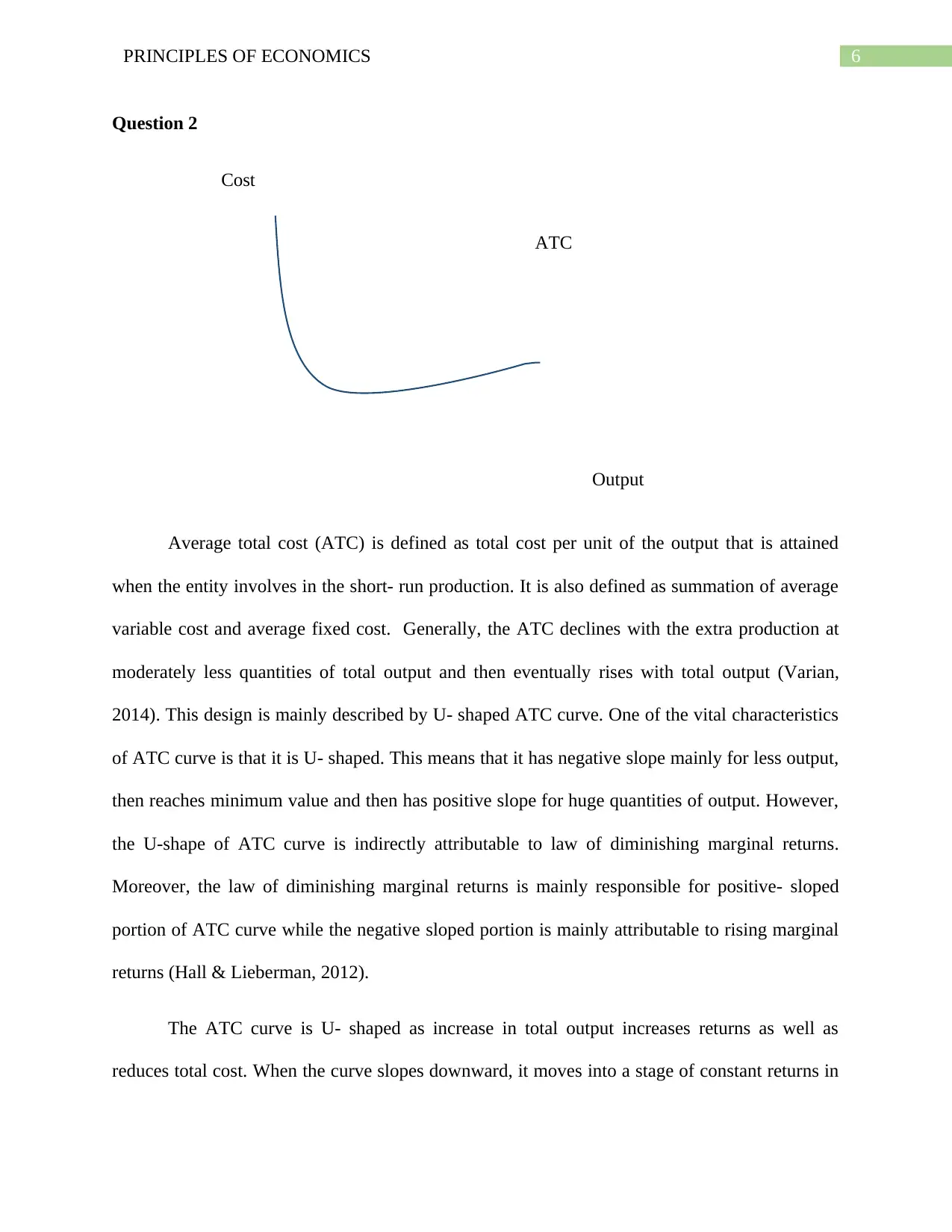
6PRINCIPLES OF ECONOMICS
Output
Cost
ATC
Question 2
Average total cost (ATC) is defined as total cost per unit of the output that is attained
when the entity involves in the short- run production. It is also defined as summation of average
variable cost and average fixed cost. Generally, the ATC declines with the extra production at
moderately less quantities of total output and then eventually rises with total output (Varian,
2014). This design is mainly described by U- shaped ATC curve. One of the vital characteristics
of ATC curve is that it is U- shaped. This means that it has negative slope mainly for less output,
then reaches minimum value and then has positive slope for huge quantities of output. However,
the U-shape of ATC curve is indirectly attributable to law of diminishing marginal returns.
Moreover, the law of diminishing marginal returns is mainly responsible for positive- sloped
portion of ATC curve while the negative sloped portion is mainly attributable to rising marginal
returns (Hall & Lieberman, 2012).
The ATC curve is U- shaped as increase in total output increases returns as well as
reduces total cost. When the curve slopes downward, it moves into a stage of constant returns in
Output
Cost
ATC
Question 2
Average total cost (ATC) is defined as total cost per unit of the output that is attained
when the entity involves in the short- run production. It is also defined as summation of average
variable cost and average fixed cost. Generally, the ATC declines with the extra production at
moderately less quantities of total output and then eventually rises with total output (Varian,
2014). This design is mainly described by U- shaped ATC curve. One of the vital characteristics
of ATC curve is that it is U- shaped. This means that it has negative slope mainly for less output,
then reaches minimum value and then has positive slope for huge quantities of output. However,
the U-shape of ATC curve is indirectly attributable to law of diminishing marginal returns.
Moreover, the law of diminishing marginal returns is mainly responsible for positive- sloped
portion of ATC curve while the negative sloped portion is mainly attributable to rising marginal
returns (Hall & Lieberman, 2012).
The ATC curve is U- shaped as increase in total output increases returns as well as
reduces total cost. When the curve slopes downward, it moves into a stage of constant returns in
Paraphrase This Document
Need a fresh take? Get an instant paraphrase of this document with our AI Paraphraser
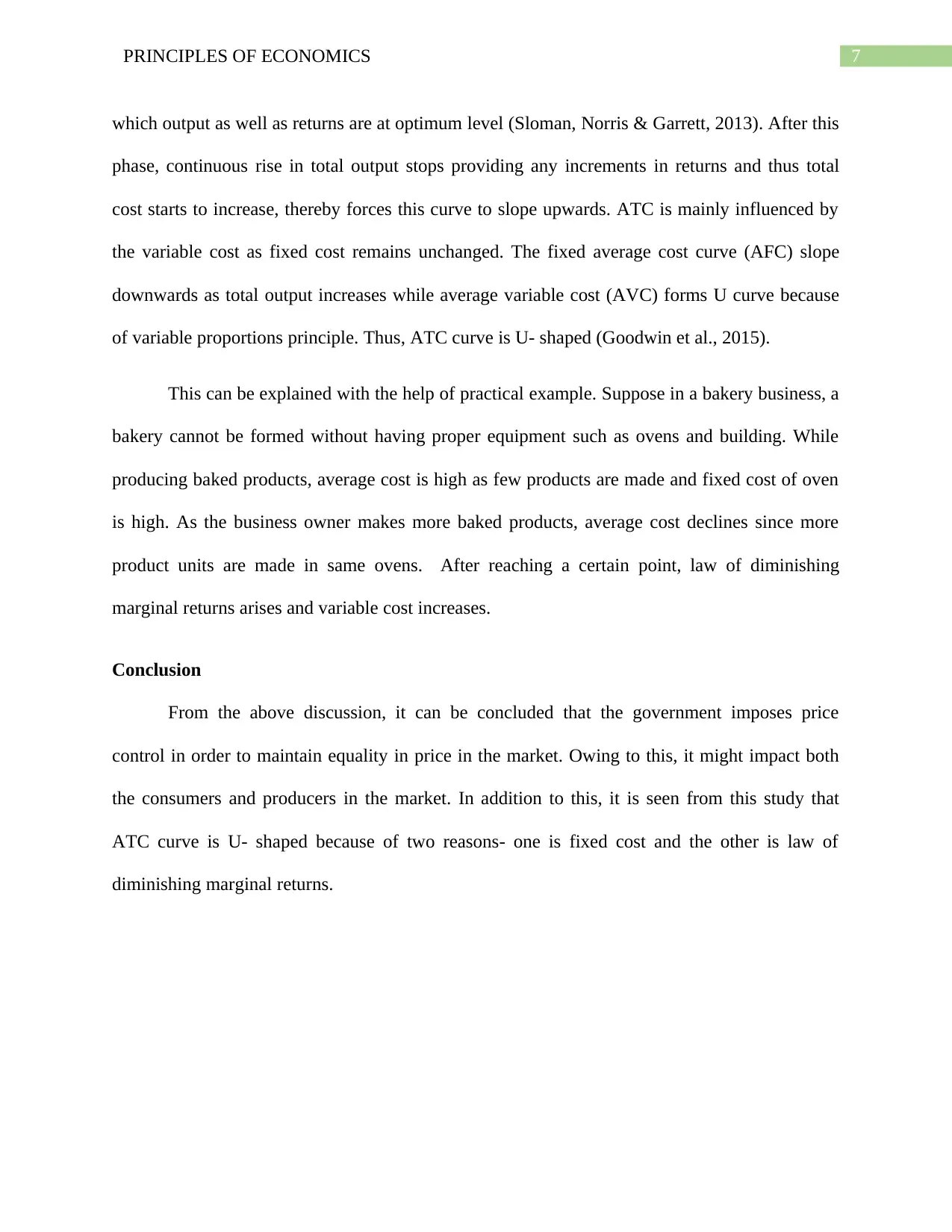
7PRINCIPLES OF ECONOMICS
which output as well as returns are at optimum level (Sloman, Norris & Garrett, 2013). After this
phase, continuous rise in total output stops providing any increments in returns and thus total
cost starts to increase, thereby forces this curve to slope upwards. ATC is mainly influenced by
the variable cost as fixed cost remains unchanged. The fixed average cost curve (AFC) slope
downwards as total output increases while average variable cost (AVC) forms U curve because
of variable proportions principle. Thus, ATC curve is U- shaped (Goodwin et al., 2015).
This can be explained with the help of practical example. Suppose in a bakery business, a
bakery cannot be formed without having proper equipment such as ovens and building. While
producing baked products, average cost is high as few products are made and fixed cost of oven
is high. As the business owner makes more baked products, average cost declines since more
product units are made in same ovens. After reaching a certain point, law of diminishing
marginal returns arises and variable cost increases.
Conclusion
From the above discussion, it can be concluded that the government imposes price
control in order to maintain equality in price in the market. Owing to this, it might impact both
the consumers and producers in the market. In addition to this, it is seen from this study that
ATC curve is U- shaped because of two reasons- one is fixed cost and the other is law of
diminishing marginal returns.
which output as well as returns are at optimum level (Sloman, Norris & Garrett, 2013). After this
phase, continuous rise in total output stops providing any increments in returns and thus total
cost starts to increase, thereby forces this curve to slope upwards. ATC is mainly influenced by
the variable cost as fixed cost remains unchanged. The fixed average cost curve (AFC) slope
downwards as total output increases while average variable cost (AVC) forms U curve because
of variable proportions principle. Thus, ATC curve is U- shaped (Goodwin et al., 2015).
This can be explained with the help of practical example. Suppose in a bakery business, a
bakery cannot be formed without having proper equipment such as ovens and building. While
producing baked products, average cost is high as few products are made and fixed cost of oven
is high. As the business owner makes more baked products, average cost declines since more
product units are made in same ovens. After reaching a certain point, law of diminishing
marginal returns arises and variable cost increases.
Conclusion
From the above discussion, it can be concluded that the government imposes price
control in order to maintain equality in price in the market. Owing to this, it might impact both
the consumers and producers in the market. In addition to this, it is seen from this study that
ATC curve is U- shaped because of two reasons- one is fixed cost and the other is law of
diminishing marginal returns.
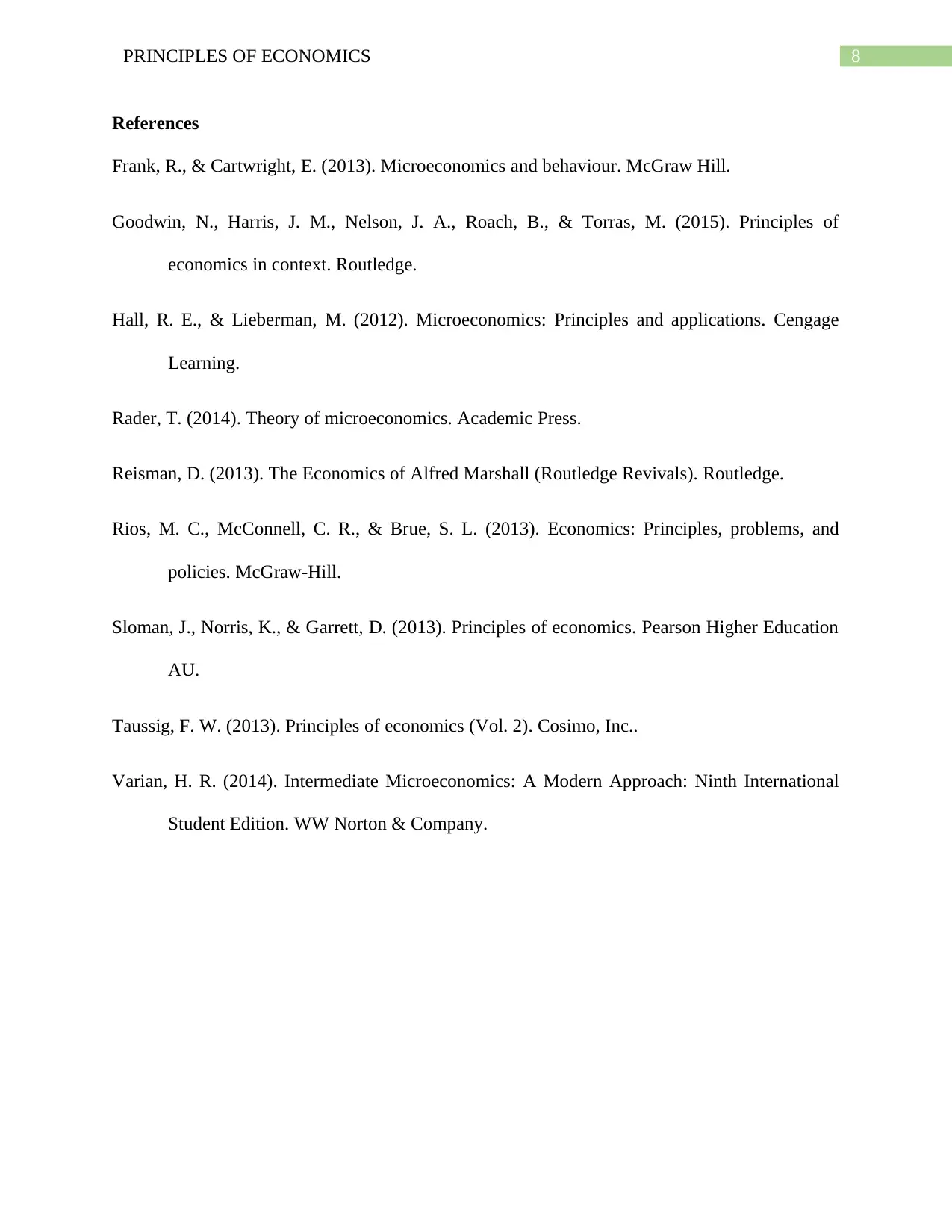
8PRINCIPLES OF ECONOMICS
References
Frank, R., & Cartwright, E. (2013). Microeconomics and behaviour. McGraw Hill.
Goodwin, N., Harris, J. M., Nelson, J. A., Roach, B., & Torras, M. (2015). Principles of
economics in context. Routledge.
Hall, R. E., & Lieberman, M. (2012). Microeconomics: Principles and applications. Cengage
Learning.
Rader, T. (2014). Theory of microeconomics. Academic Press.
Reisman, D. (2013). The Economics of Alfred Marshall (Routledge Revivals). Routledge.
Rios, M. C., McConnell, C. R., & Brue, S. L. (2013). Economics: Principles, problems, and
policies. McGraw-Hill.
Sloman, J., Norris, K., & Garrett, D. (2013). Principles of economics. Pearson Higher Education
AU.
Taussig, F. W. (2013). Principles of economics (Vol. 2). Cosimo, Inc..
Varian, H. R. (2014). Intermediate Microeconomics: A Modern Approach: Ninth International
Student Edition. WW Norton & Company.
References
Frank, R., & Cartwright, E. (2013). Microeconomics and behaviour. McGraw Hill.
Goodwin, N., Harris, J. M., Nelson, J. A., Roach, B., & Torras, M. (2015). Principles of
economics in context. Routledge.
Hall, R. E., & Lieberman, M. (2012). Microeconomics: Principles and applications. Cengage
Learning.
Rader, T. (2014). Theory of microeconomics. Academic Press.
Reisman, D. (2013). The Economics of Alfred Marshall (Routledge Revivals). Routledge.
Rios, M. C., McConnell, C. R., & Brue, S. L. (2013). Economics: Principles, problems, and
policies. McGraw-Hill.
Sloman, J., Norris, K., & Garrett, D. (2013). Principles of economics. Pearson Higher Education
AU.
Taussig, F. W. (2013). Principles of economics (Vol. 2). Cosimo, Inc..
Varian, H. R. (2014). Intermediate Microeconomics: A Modern Approach: Ninth International
Student Edition. WW Norton & Company.
You're viewing a preview
Unlock full access by subscribing today!
1 out of 9
Related Documents
Your All-in-One AI-Powered Toolkit for Academic Success.
+13062052269
info@desklib.com
Available 24*7 on WhatsApp / Email
![[object Object]](/_next/static/media/star-bottom.7253800d.svg)
Unlock your academic potential
© 2024 | Zucol Services PVT LTD | All rights reserved.





